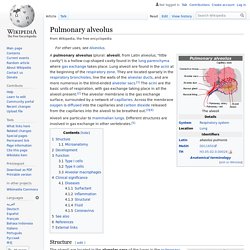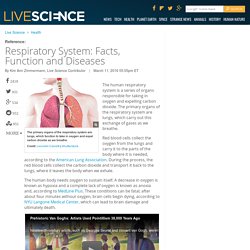

Pulmonary alveolus - Wikipedia. An alveolus (plural: alveoli, from Latin alveolus, "little cavity") is a hollow cavity found in the lung parenchyma, and is the basic unit of respiration.

Lung alveoli are the ends of the respiratory tree, branching from either alveolar sacs or alveolar ducts, which like alveoli are both sites of gas exchange with the blood as well.[1] Alveoli are particular to mammalian lungs. Different structures are involved in gas exchange in other vertebrates.[2] The alveolar membrane is the gas-exchange surface. Carbon dioxide rich blood is pumped from the rest of the body into the alveolar blood vessels where, through diffusion, it releases its carbon dioxide and absorbs oxygen.[3] Structure[edit] The alveoli are located in the respiratory zone of the lungs, at the ends of the alveolar ducts and alveolar sac, representing the smallest units in the respiratory tract.
Respiratory System: Facts, Function and Diseases. The human respiratory system is a series of organs responsible for taking in oxygen and expelling carbon dioxide.

The primary organs of the respiratory system are lungs, which carry out this exchange of gases as we breathe. Red blood cells collect the oxygen from the lungs and carry it to the parts of the body where it is needed, according to the American Lung Association.